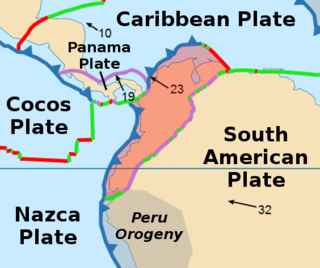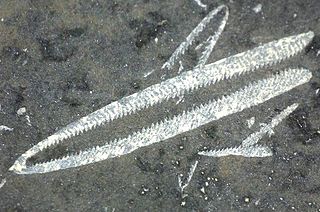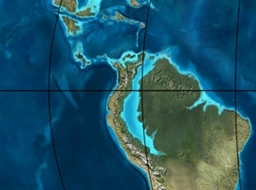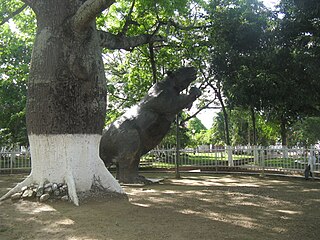Related Research Articles

The North Andes Plate or North Andes Block is a small tectonic plate (microplate) located in the northern Andes. It is squeezed between the faster moving South American Plate and the Nazca Plate to the southwest. Due to the subduction of the Coiba and Malpelo plates, this area is very prone to volcanic and seismic activity, with many historical earthquakes.
The South American land mammal ages (SALMA) establish a geologic timescale for prehistoric South American fauna beginning 64.5 Ma during the Paleocene and continuing through to the Late Pleistocene. These periods are referred to as ages, stages, or intervals and were established using geographic place names where fossil materials where obtained.
The Tiupampan age is a period of geologic time within the Paleocene epoch of the Paleogene used more specifically with South American land mammal ages (SALMA). It is the oldest SALMA age and precedes the Peligran age.
The Peligran age is a period of geologic time within the Paleocene epoch of the Paleogene, used more specifically with South American land mammal ages (SALMA). It follows the Tiupampan and precedes the Riochican age.
The Colhuehuapian age is a period of geologic time within the Early Miocene epoch of the Neogene, used more specifically within the SALMA classification in South America. It follows the Deseadan and precedes the Santacrucian age.
The Colloncuran age is a period of geologic time within the Middle Miocene epoch of the Neogene, used more specifically within the SALMA classification in South America. It follows the Friasian and precedes the Laventan age.

The Paja Formation is an Early Cretaceous geologic formation of central Colombia. The formation extends across the northern part of the Altiplano Cundiboyacense, the Western Colombian emerald belt and surrounding areas of the Eastern Ranges of the Colombian Andes. In the subsurface, the formation is found in the Middle Magdalena Valley to the west. The Paja Formation stretches across four departments, from north to south the southernmost Bolívar Department, in Santander, Boyacá and the northern part of Cundinamarca. Well known fossiliferous outcrops of the formation occur near Villa de Leyva, also written as Villa de Leiva, and neighboring Sáchica.

Didymograptus is an extinct genus of graptolites with four rows of cups. They lived during the Middle Ordovician, to Late Ordovician.

Paleontology or palaeontology is the study of prehistoric life forms on Earth through the examination of plant and animal fossils. This includes the study of body fossils, tracks (ichnites), burrows, cast-off parts, fossilised feces (coprolites), palynomorphs and chemical residues. Because humans have encountered fossils for millennia, paleontology has a long history both before and after becoming formalized as a science. This article records significant discoveries and events related to paleontology that occurred or were published in the year 2013.
Salta Basin or Salta Rift Basin is a sedimentary basin located in the Argentine Northwest. The basin started to accumulate sediments in the Early Cretaceous (Neocomian) and at present it has sedimentary deposits reaching thicknesses of 5,000 metres (16,000 ft). The basin contains seven sub-basins: Tres Cruces, Lomas de Olmedo, Metán, Alemanía, Salfity, El Rey, Sey and Brealito. The basin environment has variously been described as a "foreland rift" and an "intra-continental rift". The basin developed under conditions of extensional tectonics and rift-associated volcanism.

Acanthodus is an extinct genus of conodonts.
Kallidontus is an extinct genus of conodonts.
Utahconus is an extinct genus of conodonts.

Variabiloconus is an extinct genus of conodonts.
Cordylodus is an extinct genus of conodonts in the family of Cordylodontidae.

The Bogotá Formation (Spanish: Formación Bogotá, E1-2b, Tpb, Pgb) is a geological formation of the Eastern Hills and Bogotá savanna on the Altiplano Cundiboyacense, Eastern Ranges of the Colombian Andes. The predominantly shale and siltstone formation, with sandstone beds intercalated, dates to the Paleogene period; Upper Paleocene to Lower Eocene epochs, with an age range of 61.66 to 52.5 Ma, spanning the Paleocene–Eocene Thermal Maximum. The thickness of the Bogotá Formation ranges from 169 metres (554 ft) near Tunja to 1,415 metres (4,642 ft) near Bogotá. Fossils of the ungulate Etayoa bacatensis have been found in the Bogotá Formation, as well as numerous reptiles, unnamed as of 2017.

The Honda Group is a geological group of the Upper and Middle Magdalena Basins and the adjacent Central and Eastern Ranges of the Colombian Andes. The group, in older literature also defined as formation, is in its present-day type section in the Tatacoa Desert in the department of Huila subdivided into two main formations; La Victoria and Villavieja.

The Chibcha Terrane, named after Chibcha, is the largest of the geological provinces (terranes) of Colombia. The terrane, the oldest explored domains of which date to the Meso- to Neoproterozoic, is situated on the North Andes Plate. The megaregional Romeral Fault System forms the contact of the terrane with the Tahamí Terrane. The contact with the Caribbean and La Guajira Terranes is formed by the regional Bucaramanga-Santa Marta Fault. The northeastern boundary is formed by the regional Oca Fault, bounding the La Guajira Terrane. The terrane is emplaced over the Río Negro-Juruena Province of the Amazonian Craton along the megaregional Eastern Frontal Fault System.
The Venado Formation is a geological formation of the Agua Blanca Group, in the Eastern Ranges of the Colombian Andes, cropping out along the Venado River in northern Huila. The sequence of pyrite containing dark grey micaceous shales interbedded with siltstones and sandstones dates to the Ordovician period; Middle to Late Floian epoch, and has a maximum thickness of 670 metres (2,200 ft) in the type section.
References
- ↑ Monographie der fossilen fische des silurischen systems des Russisch-baltischen gouvernements. CH Pander, 1856
- ↑ Catalogue of Conodonts, Willi Ziegler, 1977
- ↑ New conodont species and biostratigraphy of the Santa Rosita Formation (upper Furongian–Tremadocian) in the Tilcara Range, Cordillera Oriental of Jujuy, Argentina. Fernando J. Zeballo and Guillermo L. Albanesi (2013), Geological Journal, 48 (2–3): 170–193, doi:10.1002/gj.2425
- ↑ New conodont taxa and biozones from the Lower Ordovician of the Cordillera Oriental, NW Argentina. Gustavo G. Voldman, Guillermo L. Albanesi, Gladys Ortega, María Eugenia Giuliano and Carlos Ruben Monaldi (2016), Geological Journal, in press, doi:10.1002/gj.2766
- 1 2 Acodus at Fossilworks.org
- ↑ Moreno et al., 2008, p.10
Bibliography
- Moreno Sánchez, Mario; Jesus Gómez Cruz, Arley de; Castillo González, Hardany (2008), "Graptolitos del Ordovícico y geología de los afloramientos del Río Venado (norte del Departamento del Huila)" (PDF), Boletín de Geología, 30: 9–19, retrieved 2017-03-31